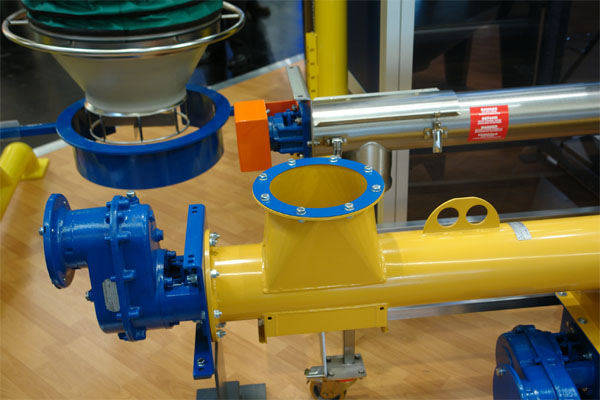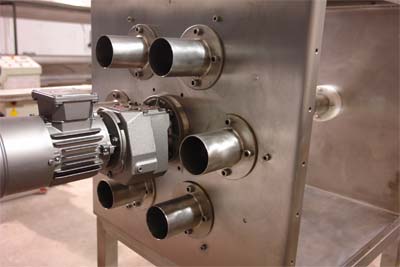1. Dilute phase pneumatic conveying
vacuum operation
2. Dilute phase pneumatic conveying pressure operation
3. Dilute phase pneumatic conveying pressure-vacuum operation
4. Dense phase pneumatic conveying pressure operation
Dense Phase
Dense Phase pneumatic transport-pneumatic conveying operation is used particularly for transfer of
aggressive and difficult materials. Sand, cement and glass industry
can be shown as example in this respect. Here, as the material is
aggressive it does not strike the pipe wall sharply, but moves
solidly by an air-product mix under high pressure of 2-5 bars and is
product to far distances. For example, bulk cement tankers operate
by this method. In this transfer method, unlike the fans with high
flow rate in the dilute phase, the screw compressors and
dehumidifiers at high flow rate are used.
High pressure air is delivered to the container full with the
product to be transferred and then the high pressure air-product mix
is transferred by the opening valve to the cyclone, silo or target
mixer. This method is used especially if there is material in the
process which may become fibrous or give damage to the
characteriStic of the product due to friction. The dense phase
operates with instruments different than those of the dilute phase
due to the transfer mechanism. The transport equipment are more
resistant compared to those of the dilute phase. In this transfer
performed by high pressure air, the thick-wall pipes and special
basalt elbows are used.
In the pneumatic transport- pneumatic conveying Centrifugal or Roots type blowers used as
air generators suck the air in the environment by vacuum and
develops thrust pressure by compressing the air. Due to relative
humidity of the air in the atmospheric environment, the water
particles serves as a good conductive during generation of the
pressure and, therefore, cause heating of the transfer air. This
temperature may occasionally reach up to 80oC depending on the
operating pressure of the process and drifting speed of the
transfer.
If the target transport material has a structure susceptible to
these temperatures, the operations of pre-cooling in the process and
final cooling before introduction of the air in the process may be
required. Because of the air temperature and speed, the most
appropriate solution may be Densifier, Transporter and Dense phase
transporter instead of complex structure of the dilute phase.
Click for Dense Phase Transfer Systems




Dilute Phase
Pneumatic transport-pneumatic conveying mostly preferred for granular and power
articles or products. The speed varies 12-25m/s depending on the
phase density of this transfer made by air. Transport method in the
pneumatic transfer is two types, namely dense phase and dilute phase.
Transfer operation in the dilute face is performed by vacuum or
pressure. The transport operation is generally performed in the
pressure range of 250-600mbar. These two methods should be
diStinguished depending on the process of these two methods.
Click for Dilute Phase Transfer Systems
(Vacuum, Pressure)-Blower
Mechanical Transport
Although the Mechanical Transport seems difficult and has a set of
patterns, it is the most cost-effective solution for electric power.
Investment cost is high in the long distances, but use of power is
less. In general, it is also used for transfer at fixed flow rate
volumetrically for all pneumatic transport operations.
Pneumatic transport-pneumatic conveying is the most flexible transport method compared
to the screw spiral, band and chain conveyor. Although many
secondary instruments and dust separation systems should operate
together, it is the most preferred transport system thanks to this
flexible structure.
Each product transported by air is first mixed with the air and then
separated from the air. Although both operations are difficult, it
is preferred due to its flexible structure.
While the mixing operation is performed by help of rotary valves,
loading stations and venture, the separation operation is performed
by means of filters. On the other hand, pneumatic means dust, dust
separation and absolute filtering.
Blowers are used as generator of air, the transport source; in other
words, the fans of low pressure high flow rate of air are used.
However it seems that the transport is performed by mixing process
pressure air with the product, it requires serious engineering
operation and experience. On the other hand, pressure and vacuum may
also be used in the pneumatic transport processes.
Each product to be transported pneumatically bears different
characteriStic. For this reason, density and efficient transport
pressure of each product differs. And this, in turn, differs ways of
transport. If you attempt to transport sugar on a line used for
transport of flour without any modification, your line is doomed to
fail as it may be expected normally. None of the equipment you use
may operate properly. If the process is designed correctly and it is
operated with proper instruments and equipment, you may transport
both sugar and flour on the same line after making parametric
changes in the automation system. This example shows necessity of a
serious infrastructure and concept of experience in the practice.
pneumatic conveying,pneumatic
conveyor,pneumatic transport,pneumatic conveying design, pneumatic
conveying, pneumatic conveying systems, pneumatic conveying system,
conveying powder, air filtration, vacuum conveying, dilute phase
conveying, continuous dense phase conveying, industrial air
filtration, hepa, high efficiency air filters, mac pulse jet air
filters, ventilation, airlock, rotary airlock, rotary valve,
material,pneumatic transport, management, bulk material handling,